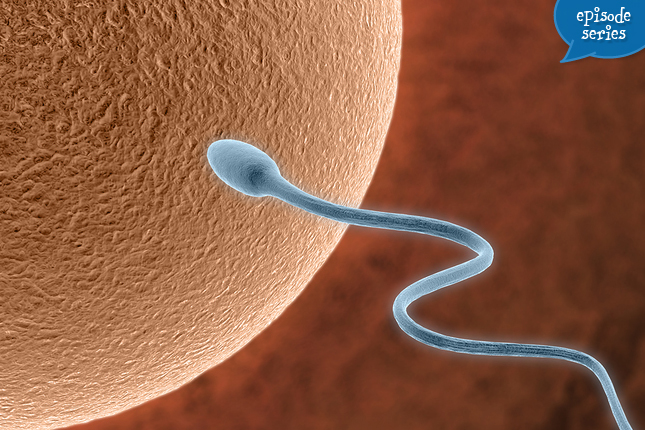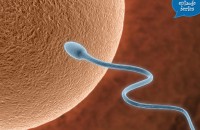Preggie Palls
Getting Pregnant: Ovulation, Fertilization and Implantation
Please be advised, this transcription was performed from a company independent of New Mommy Media, LLC. As such, translation was required which may alter the accuracy of the transcription.
[00:00:00]
[Theme Music]
Susana Park : The process of conceiving a child is nothing short of a miracle. When is the best time to get pregnant? And what exactly is happening within the body to make it possible? I'm Dr. Susana Park, a fertility specialist with the San Diego Fertility Center, and today we're talking about getting pregnant: ovulation, fertilization and implantation. This is Preggie Pals, episode 51.
[Theme Music/Intro]
Sunny Gault : Welcome to Preggie Pals, broadcasting from the Birth Education Center of San Diego. Preggie Pals is your weekly online on the go support group for expecting parents and those hoping to become pregnant. I'm your host, Sunny Gault. OK, the countdown has begun, we have less than one week for you to get your tickets online to the Your Natural Baby Fair on April 27th, right here in San Diego. Visit yournaturalbabyfair.com and use promo code “mommedia” for 15% off. We will also have a booth at the event and we'll be broadcasting live, video interviews and demonstrations. If you don't live in the area, please visit the fair website and learn how you can watch it live. And a special thanks goes out to all of the members of the Preggie Pals Club; our club members get all of our archived episodes, bonus content after each new show, plus special giveaways and discounts. You'll also get a free subscription to Pregnancy Magazine. Be sure to download the latest issue of Pregnancy Magazine to check out our full page add. And you can visit our website preggiepals.com for more information on our members' program. Just a couple more announcements, first of all, my lovely voice, I bet many of you guys wonder “what's going on with Sunny today?”, well, my little toddler, bless his sowl, was out on the playground, caught some sort of bug and of course, I was taking care of him, trying to nurse him back to health, and in the process I caught something too. You should see us here in the studio, I'm like as far away as I can be from Nikki, and from Dr. Park, so I don't get them sick. Anyways, that's what's up with my voice, I'm not trying to sound sexy, this is not my Katharine Hepburn imitation or anything, this is just me being a mommy. And speaking of being a mommy, I do have another announcement to make, and I swear I did not plan this with today's episode, but my husband and I just found out that we are pregnant with our third baby! We're very excited about this, some of you guys know from listening to the show that with our first baby we had some fertility issues, we had a hard time getting pregnant, and got pregnant really easily with number two and again with number three, so hopefully that gives you guys just some hope out there, for those of you who still try to become pregnant. The body does recognize it, and sometimes it's easier in the future. So, with that being said, I have Nikki here in the studio joining us, Nikki, tell us a little bit about yourself.
Nikki Helms : My name is Nikki Helms, I am 41, I am a postpartum doula, and I have two little girls, Nina and Naia, who are 8 and 2, and they were both born by C-section, I hoped for a natural birth but that was not the way that it worked out. But I got my two little girls, I'm super happy.
Sunny Gault : I am so gealous, you got to give me some vibes or something, even though the gender has been determined, we'll talk about that a little bit later, but that's great, thank you for being on our show today. And Dr. Park, do you have any kids?
Susana Park : I do, his name is Usher, he is actually nine months-old.
Sunny Gault : Oh my goodness, you're a new momma too!
Susana Park : I am, and I joined the club with you ladies for a C-section, so I know my territory very well. I was a patient.
Sunny Gault : I think that's a great perspective to have.
Susana Park : Absolutely.
Sunny Gault : Great, well thank you ladies for being here.
[Theme Music] [Featured Segments: News Headlines]
Sunny Gault : Before we get started, here's a look at the popular pregnancy headline in our net, all of our headlines are posted to our Preggie Pals pinterest if you want to check them out. Here's the story, there was a father I Iowa, he was pulled over for speeding while his wife actually delivered a baby in the passenger seat of their SUV. And he actually admitted that he did not plan to stop, but there was a red light and the traffic basically forced him to stop, and this poor police officer stops his car and the guy is like shouting, “My wife's going to have a baby! My wife's going to have a baby!”, and I think the police office actually helped deliver this baby. I think it was kind of coming out as he was stopping the car. And I know with a lot of people this is something that you have nightmares about as a pregnant women, “am I going to make it to the hospital in tim?” We actually did an episode recently on precipitous labor. And this does happen to some people, and of course when it does it makes the headlines, so what would you guys do if you were in the car, on your way to the hospital and a police officer is going to pull you over for speeding? Do you just go? In this case he had to stop because of the traffic, but what would you do? Nikki? Any thoughts on it?
Nikki Helms : Well the last time I was in labor my husband and my mother in law were on their way to the hospital and I laugh, because I know that if my husband was driving, he would have just barreled down and it wouldn't have made any difference. My mother in law however was following the traffic laws, but I'm sure that he wouldn't have and just tell them that they'd have to give us a ticket at the hospital.
Sunny Gault : For me, it would probably depend on who was driving, if it was my husband, we just would have barreled through and would have dealt with whatever repercussions, my father is an insurance agent, so I think it's safe to say that he would be like going whatever the speed limit is, 65 miles an hour, whatever, he would stop and obey all traffic signs. What about you, Dr. Park, what do you think about this?
Susana Park : If it was me driving, I would definitely barrel through the traffic, my husband, I don't think he would. He would probably tell me to deliver it myself! “Don't you know how to do this?”
Nikki Helms : Why are we panicking? You're a doctor.
[Theme Music]
[00:06:41]
Sunny Gault : Today on Preggie Pals we're talking about what happens within the body in order to get pregnant. We know that many of our listeners are trying to become pregnant, and we hope this episode sheds some light on the process. And our expert, as you already heard, is Dr. Susana Park, she is a fertility doctor with the San Diego Fertility Center. So welcome to the show, Dr. Park!
Susana Park : Thank you for having me!
Sunny Gault : Welcome back to the show, you were on an episode about genetic testing and counseling and all of that, so you guys be sure to check that out. So let's dive into this, getting pregnant naturally is all about timing, so let's talk a little bit about a woman's ovulation cycle and how it works.
Susana Park : It's pretty amazing the whole process of becoming pregnant, and it's amazing how many people actually can become pregnant. The first step in ovulating is you need an egg. So what happens is every month when you start your menstrual cycle, your body goes into its supply of eggs and pulls out a group of eggs. And that group of eggs has a name, it's called antral follicles, and within that group of eggs, there is a competition of which there is one winner. And the eggs that don't become winners, the losers, undergo cell death, so they die every month. So every month you lose multiple eggs.
Sunny Gault : And is that what we see as our period?
Susana Park : No. You don't even notice that you've lost it. It's a very common myth that patients think that they only lose one egg a month. You only ovulate one egg a month, but you lose multiple eggs a month.
Sunny Gault : Nikki, did you know that?
Nikki Helms : I did not know that.
Sunny Gault : I just thought there was one egg. Now I'm curious how an egg is selected out of this group.
Susana Park : The champion is the egg that has a hormone called fsh, and lh, they are secreted by our brain. So the egg with the highest content of fsh receptors becomes the winner. Because that's the one that get's the most fsh hormone and becomes the biggest egg.
Sunny Gault : So it really is kind of survival of the fittest.
Susana Park : Absolutely. And then that one egg is the one that continues to grow and get bigger, and as it gets bigger, it secretes estrogen. So the estrogen level in your body starts to rise, and it reaches a point where it's high enough that it automatically signals your brain to secrete lh at a much higher concentration. And that spike in lh from your brain is a signal to your ovary to release that matured egg, and ovulate.
Sunny Gault : And about what time in our cycle does this typically happen?
Susana Park : It's different for every woman. So let's talk about the typical 28 day cycle. That's very confusing for a lot of women, there is actually a mathematical way to calculate when you ovulate, but it requires keeping a menstrual diary. The first day of full flow not spotting is what we call day 1. And then every day just march out, day 2, 3, 4, you just keep counting on the calendar. And then when you get your period again, that's the last day of your cycle, so let's say it was day one, to 28 days when you got your next period. That means that you have a 28 day menstrual cycle. And then you substract 14 from that number. So 28 – 14 is 14. So then you know that you tend to ovulate on day 14. So if your cycle is let's say 39 days, 39 minus 14 is 25, so you will ovulate on day 25 of your cycle. So the longer your cycle, the later you ovulate. Because what changes in a menstrual cycle is the time from when you get your period to how long it takes your egg to be ready to ovulate. Once you ovulate though, from that time to when you get your next period is pretty much set. This is information is so important because it helps you time. So let's say – we'll go back to the standard 28 day cycle – so let's say you ovulate day 14, the ideal way to time it, without using any paraphernalia, is say, OK, ovulate day 14, but you could be off by a day or so, so start having sex every other day a few days before. For example, you'll start having sex on day 10, then 12, then 14, then 16. And then you've pretty much covered your base, because sperm can live in your body for about 2 to 4 days. So even if you're off by a day, it doesn't matter. Let's say you ovulate at day 14, but you didn't have sex day 14, because you had sex day 12, and then day 14, that's OK, because that sperm from day 13 it's still hovering around in your body.
Sunny Gault : What is the sweet spot for the egg being in the right area at the right time to have sex?
Susana Park : The egg, once released, has to be fertilized within 24 hours.
Sunny Gault : That is a very narrow window.
Susana Park : Exactly.
Nikki Helms : I wonder why we get pregnant.
Susana Park : But sperm lives in your fallopian tubes for 2 to 4 days. So, if you go into having more sex than not enough sex, so the sperm is in your fallopian tube, and it hangs out there for a couple of days, so when you ovulate – even though you didn't get the timing just right, at least the sperm is still around. And then the other thing is sometimes I have patients and they have sex and they're not getting pregnant, because they've been having sex every day of the cycle, and that's not good. Because you need that sperm to be fit, and fit sperm is sperm that has been ejaculated every two to five days. So don't have sex every day. Because, for example, let's say you say, “Alright, we're going to start having sex day 10, we're going to do it every day”. Well, then by the time you get you day 14, he's worn out of sperm. The quantity is lower, the quality is not good, but the converse is also true, sometimes I have couples and they say, we didn't have any any sex, we're just sort of waiting for day 14 to have sex, because we're saving everything up. That's also not good. Because then the sperm he's ejaculating is “old”.
Sunny Gault : It's lazy, doesn't want to travel.
Susana Park : That's exactly right! Which is why you want to start having sex a few days before you expect your ovulation, so that that sperm's already been ejaculated so the sperm you get at the time of your prime ovulation is really the best sperm.
Sunny Gault : I'm going to go back and talk a little bit more about the egg. What is the egg comprised of?
Susana Park : It's a little bit complicated, but it's pretty amazing. The egg, compared to the sperm, is huge. You have the oocyte, and then around that you have another layer called the Zona Pellucida, and then around that you have another layer called Corona Radiata, and then around that you have this really big water and a big membrane, which is really your follicle. So we use the word follicle and egg interchangeably, but they're really not the same. So if I did an ultrasound, I can see your follicle on the ultrasound, it's a really big black surface – as you know Nikki, when you had your treatments, right?
Nikki Helms : Yes, exactly.
Susana Park : But you can't really see an egg, you need a microscope, but inside that follicle, within that water structure, lies your little egg. And we know that there's a correlation between the diameter of the follicle, the black circle and the maturity of the egg. So when you ovulate, that little egg comes out of the black fluid, the black circle, and goes out from your ovary into your fallopian tubes.
Sunny Gault : How long does it take for the egg to travel to where it needs to be?
Susana Park : Very quick. Because the egg just needs to be at the very end of the fallopian tubes. So the sperm comes to the egg in the fallopian tube. The egg does not go to the sperm.
Sunny Gault : Men should come to us. That is a metaphor for life itself.
Susana Park : So the sperm and the egg meeting always happens at the very end of the fallopian tube, we call it the distant end, the end of the tube that's closest to the egg. It does not happen at the beginning of the tube, the side closest to the uterus. The sperm has to make it all the way to the end of the fallopian tube, because at the end of the tube – the little tubes have little cilia, and they swipe over the ovary and so doing that motion, that's how it picks up the egg. And then the sperm should be there, the sperm and the egg meet right away, but at the very end of that fallopian tube.
Sunny Gault : So if there's no sperm there, the egg just kind of hangs out at the end of the fallopian tube?
Susana Park : That's right, and at the 24 hours, it dies. It's over. So the timing is off in this example.
Sunny Gault : OK, we talked a little bit about what the egg is, can you release more than one egg?
Susana Park : Yes, you can.
Sunny Gault : And does the process change if you do?
Susana Park : The process is the exact same, the quantity differs. But releasing more than one egg happens naturally more often in the very young women, and the very old women. Teenagers and women in their 40s are more likely to just spontaneously have twins than women in their 20s or 30s.
Sunny Gault : And that would be fraternal twins, right?
Susana Park : Usually, correct.
Sunny Gault : Can you ovulate more than once in a cycle?
Susana Park : No.
Sunny Gault : It's physically impossible?
Susana Park : Impossible.
Sunny Gault : But it is possible to not ovulate, which leads to some of the complications that women may have.
Susana Park : Exactly.
Nikki Helms : I didn't really understand that just because you get a period does it necessarily mean that you've ovulated? They're not mutually exclusive. And so what I found out after we have been trying for a year and a half, two years, naturally and timing and trying to figure out doing the math, we realized after going to fertility specialists, that I wasn't ovulating regularly, and I had a really hard time processing that, because I had a period every month, so what's going on? Little did I know that just because I had a period the ovulation was not necessarily happening.
Susana Park : There are ways that you can check to see if you're ovulating. One of them is, if you know you ovulated – 'cause a woman can feel it, some women can check it on a kit which I'll get to in a second – but if you know you've ovulated, then a week later, you can check your blood for a hormone called progesterone. And that progesterone level should rise. And if it rises, then you've confirmed that you have indeed ovulated. But you're right, sometimes a patient will go for the progesterone and they look at the number and I'm just surprised, it's low, and so I know that when she thinks she's ovulating, she's really not ovulating, and the timing is the problem.
Sunny Gault : So how do you get the timing right?
Susana Park : Many women know about ovulation kits. What it checks for is a hormone called lh, luteinizing hormone. A pregnancy kit check for a different hormone called hdg. There are two types on the market, the most common is where you look for the double line, one line is a control and then your other line should be as dark, if not darker, that tells you that ovulation is impending. It does not mean you are ovulating that second. So it's the other complaint I get from women, “I told him we had to have sex right there, right then”, and I'm like, “No! That's not what it means”. But it means that you should have sex that day, because ovulation is going to happen probably within 24 hours. It can be either within 12 hours. So you should be having sex that day.
Sunny Gault : I didn't know it was that quick, I thought it was like within 48 hours, so sometimes I would wait a couple of days pass that. It's so confusing! It's like wait, don't wait, go, stop.
Susana Park : I tell patients the best thing to do is have sex that day, and then just do it again the next day, just in case, you never know.
Sunny Gault : What about testing the thermometer test?
Susana Park : The basal body temperature – a lot of people think that it helps predict when they're most fertile, it doesn't. The basal body temperature tells you ovulated. It doesn't tell you that you are about to ovulate. The way it works is, when you ovulate, the progesterone that I mentioned before that you check in your blood, that progesterone makes your temperature go up in your body. So what the basal body temperature shows is your temperature spike, so it shows you ovulated. It doesn't tell you that you are about to ovulate.
Nikki Helms : I didn't know that!
Sunny Gault : Because I know women that swear by that test. But I've always done ovulation kits, but they swear, if you track it, you know exactly, but it's after the fact!
Susana Park : But you can look at that, because you can look at your past cycle and say – OK, my temperature went up on day 17, so you know for the next month. But it's not going to help you that much.
Sunny Gault : OK, we're going to take a quick break and when we come back, we're going to talk about what happens once the egg becomes fertilized. We chatted about it briefly, but I want to get into some details. We'll be right back.
[Theme Music]
[00:20:01]
Sunny Gault : Welcome back everyone, today we're learning about how the female body becomes pregnant. And Dr. Susana Park is here joining us, she is a fertility doctor from the San Diego Fertility Center. She's our special expert. OK, Dr. Park, I want to talk about sperm, what are sperm? I know that there are so many that are released, obviously that depends on the man, and probably how often you're having sex, but what is it comprised of?
Susana Park : A sperm is composed of two parts, a head and a long tail. As simple as it is, it's actually very very important, because in the head houses so many important things, number 1, enzymes. The enzyme is important when the sperm fuses with the egg to break down the membrane of the egg, and inside the sperm is also the male DNA. The tail is super important because this is what propels the sperm to get to the very end of the tube, where it will find the egg. And it's very interesting, because if you do a seamen analysis, a lot of men think – my sperm count is great, and that's all they want to know. But it's more than that. You want moving sperm, because you can have a lot of sperm, but if they're just lazy, doesn't help you get impregnated. And the third thing of course is sperm shape. Surprisingly, a lot of sperm are not normally shaped. By normal I mean a small head a long tail; there's a lot of sperm that have the heads too small, and the heads to big, or double heads, double tails, too short tails...
Nikki Helms : Oh my goodness!
Sunny Gault : I have some really weird visuals.
Susana Park : Yeah, so sperm is actually very important.
Sunny Gault : And then the question about how many are released in healthy dosage – I don't know if that's the right word – but how many are typically released?
Susana Park : Millions. Typical concentration-wise, you want at least 15 millions sperm per milliliter of fluid.
Sunny Gault : And each of those could be a child, right? This is what I have a hard time wrapping my brain around, how any of us were chosen to become a baby, a child, because it is survival of the fittest. In fact, I want to mention that there is a video we are going to link to our episode page, it's from Baby Center, and it's a feritilization video, and this is really what prompted me to do this episode, because they have a very dramatic way of presenting this, about how sperm travels through the body, until it fertilizes the egg and what happens to the egg afterwards. And honestly, it's just such an amazing process. You just wonder how we all made it here.
Susana Park : I saw the video, and I love it, the sound effects were great, the visuals were great, but it's really accurate. So when a man ejaculates, he ejaculates in the vagina, not in the uterus, so all the sperm gets deposited in the top of the vagina. Everybody has experienced, after sex, you get up and water comes out of it, that water is water that's opposed to commodity, because a lot of protein is in there, and if that protein gets into the uterus, it will cause a lot of cramping, so mother nature, so smart, she makes sure that that fluid doesn't go inside the uterus. But of course, there is also a lot of sperm in that fluid as well. And then the sperm from the top of the vagina has to find the opening of the uterus by itself, so the first part of the uterus that it hits is the cervix, so a lot of the sperm gets through that cervix and some of it gets caught in the cervix; and then the sperm has to go through the uterus itself, some of it get's caught in the uterus, and then the sperm has to go through both fallopian tubes, because it doesn't know which side it ovulated.
Sunny Gault : And it doesn't have eyes to be able to see, because I'm picturing this and I wonder what is it, a sixth sense? How does it know where to go? Just biology?
Nikki Helms : Well you know men don't have good sense of direction, right? Only one out of 15 million makes it...
Susana Park : By the time the sperm reaches the fallopian tubes, they're down to a couple of hundred, so you've actually lost a lot of sperm on the way.
Sunny Gault : So then as far as entering the egg, what propels the sperm to do that, 'cause it's not necessarily the first one to it, though, right?
Susana Park : That's correct, it's not. And in that video that you mentioned, it really shows it so nicely, a huge egg – because the egg is much much bigger than the sperm, with all these tiny sperm just around it, and that's really what happens in real life, and this is where sperm shape is essential, the sperm has to be normally shaped to bind to a receptor on the egg. So it's not the first sperm that gets there, it's the sperm that gets there that can bind to the receptor. And then it unfolds a chain of events. So that's the fittest sperm. And once it binds the receptor, all the enzymes that were housed in the head of the sperm opens up and breaks down the membrane of the egg, and then the sperm DNA gets released into the eggs DNA. And when that membrane of the egg breaks down, a heart shield forms around the egg, it's called a zonar reaction, so no other sperm should fertilize the egg.
Sunny Gault : How quickly does that happen?
Susana Park : Instantaneously.
Sunny Gault : So egg and sperm have united, what happens within the body during that couple week period before we even know we're pregnant?
Susana Park : The egg is made in the fallopian tube. The embryo then goes backwards, through the tube, to go back into the uterus. And it takes about three to four days to make that transit. And in its transition, the embryo begins to divide. So on day one, it has two cells, on the second day, when it's in the middle of the fallopian tube, it has four cells, on the third, when it's in the beginning of the fallopian tube, about to enter the uterus, it has eight cells, and now it's entering the uterus, now it has many many cells, so by the time it implants, is usually about five to six weeks old, and by that time it has a couple hundreds of cells. And that's when it implants into the uterus.
Sunny Gault : And about what day of our cycle would that happen?
Susana Park : At this time, you are about one week after you've ovulated. And if you wait another week, you start to know if you're pregnant or not, because when the embryo impregnates, it secretes a hormone called hsg. And that's what you pick up on your pregnancy test.
Sunny Gault : It's been quite educational, seriously, it's amazing that all that happens. Well, Dr. Park, thank you so much for joining us today. For more information about our expert and our panelists, visit the episode page on our website. This conversation continues for members of our Preggie Pals Club, after the show we'll talk about the accuracy of home pregnancy tests. To learn more about our club, you can visit our website at PreggiePals.com.
[Theme Music][Featured Segments: Ask the Experts]
[00:27:09]
Sunny Gault : We have a question from one of our listeners, this comes from Rachel, of New York City. And Rachel says, “I have yet to pass stool since having my peanut – I'm assuming you mean your child – I'm having bad stomach cramps and the urge to go, but nothing.” Oh my gush, Rachel, I had something very similar happen, and no, it is totally not fun. Rachel says, “I'm getting really really uncomfortable and I've been eating foods high in fiber. Oh, help!”
Nicholas Capetanakis : Hi Rachel, this is Dr. Nicholas Capetanakis, I'm an OB/GYN in San Diego, California, and I got your message and I think it's a great question. Pregnancy, with progesterone, does slow down your intestines, and a common complaint that we do hear is constipation. One of the things that I like to tell my patients is to talk to them about fiber. There are some great fiber products that provide a tremendous amount of fiber, just take it first thing in the morning. Be careful with meals that don't have a high fiber content, so start with a nice shot of fiber in the morning, it will usually get things going. The other thing I talk about is white products, white food, white rice, white bread, all that has to go. Everything has to be whole wheat and fiber loaded. If you feel like you have to have a bowel movement and you can't, you do anima, anima cleans up the lower end of the colon, you can always do Kool-Aid, which is a stool softner, it doesn't necessarily help you go to the bathroom, but it can make stools softer. And you can always do miralax. The other big thing is water. Water, water, water. You need to drink about three liters of water per day. And that should take care of your problems. If not, and you don't have a bowel movement in 5 to 7 days you have to let your OB/GYN know. Thanks, have a great day!
[Theme Music]
Sunny Gault : That wraps up our show for today, you appreciate you listening to the Preggie Pals, don't forget to check out our sister show Parent Savers, for parents of newborn, infants and toddlers, and our show the Boob Group for moms who breastfeed their babies. This is Preggie Pals, your pregnancy, your way!
[Disclaimer]
This has been a New Mommy Media production. Information and material contained in this episode are presented for educational purposes only. Statements and opinions expressed in this episode are not necessarily those of New Mommy Media and should not be considered facts. Though information in which areas are related to be accurate, it is not intended to replace or substitute for professional, Medical or advisor care and should not be used for diagnosing or treating health care problem or disease or prescribing any medications. If you have questions or concerns regarding your physical or mental health or the health of your baby, please seek assistance from a qualified health care provider.
[00:30:06]
[End Of Audio]












